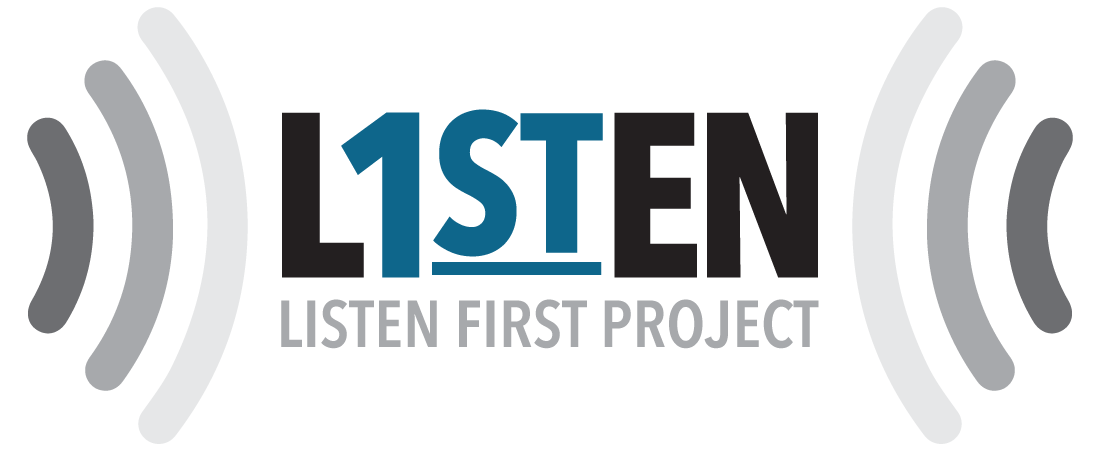Conversation Tips
A #ListenFirst conversation is any conversation that helps us see each other across differences and discover human connection. It might be between two friends or among many strangers. It might be on a park bench, in a classroom, in the workplace, at home, or online. Regardless of where you are or who you're with, here are our favorite tips!
3 Key Tips for a #ListenFirst Conversation
Listen with curiosity
Speak from your own experience
Connect with respect
Top 10 Tips for a #ListenFirst Conversation
1. Allow others the courtesy of silence while they are speaking.
When we are cut off while driving we get road rage; when we are cut off while speaking, we get conversation rage. One of the quickest ways to raise negative emotions in conversation is to interrupt someone. Whenever you feel the urge to express your opinion, replace that with an “mhm” or “yeah, right” to show you are listening.
2. Maintain a calm and respectful tone when you are speaking.
If you are passionate about something it is only natural to become animated and energetic. What seems like expressed passion to you, however, can become intimidating for your conversational partner, especially if you operate with a raised voice and hand gestures that border on pointing.
3. Come with an open mind, ready to learn and grow.
Part of the beauty of meeting new people and having conversations is to expand our horizons. We visit new places to gain new experiences, and we read new books to spark learning. Think of conversations as a bit of both, and come with the mindset expressed by Bill Nye, “Everyone you will ever meet knows something you don’t.”
4. Listen to others as you want them to listen to you.
Our first three guidelines can really be summarized by this iteration of the Golden Rule. Think about how you want to be treated in conversation - with dignity and respect - and vow to treat your partner in that way.
5. Listen to and consider others' views before sharing your own.
It is natural to want to share your opinions and give your two cents. For many listening situations, however, your opinion does not matter. People don’t always talk to you to hear your side of the story. More often, people want to tell their own side of the story and for you to listen to it without interruption.
6. Be present and curious rather than thinking of how to respond.
Steven Covey is often quoted as saying, “Most people do not listen with the intent to understand; they listen with the intent to reply. They're either speaking or preparing to speak.” Being present means being focused on the other person, genuinely curious about them and their story. When you are present and curious, the conversation will be more meaningful for both you and your partner.
7. Fully engage, free of distractions.
One of the main distractions today is our cell phone, and research shows that even its presence can influence our ability to remain present. Cell phones have an off button for a reason, and if this conversation is important enough to garner your attention then it is important enough to use that button. Stay focused on your conversational partner, maintaining eye contact with them and not your surroundings.
8. Restate what you heard to clarify understanding, using "I" statements (“What I heard you say was” or “The way I understand your position is”).
Although you can show you are engaged by freeing yourself of distractions and maintaining eye contact, studies have revealed that what you say as a listener is crucial. When you use restatements to illustrate how you have understood the speaker, you allow them to either agree (“Yes, that is what I meant!”) or to clarify their position (“Actually, what I meant was …”). Importantly, restatements are not repetitions, meaning you should not merely repeat exactly what they said. Instead, put it in your own words, and signal that this is your understanding by starting your statement with “I.”
9. Ask thoughtful and respectful questions, free from judgement, assumption, or bias.
A sure fire way to get someone talking is to ask them a question – the way that our language is structured, questions demand answers. But be careful! Don’t frame your questions as a form of judgment (e.g., “Don’t you think that your opinion is old fashioned?”). We are judged enough in the course of our day; do your best not to add to that.
10. Seek to discover common interests and areas of agreement by focusing more on why than what, more on personal experiences than positions.
There is no quicker way to end a conversation or escalate to conflict than to start spouting facts. In general, facts should not be your first line of defense, even if they are your initial go-to. Research shows people are much more likely to consider other points of view when there is an emotional connection, a relationship. Rather than start with “how are we different” start with “what are our shared core values.” Get your partner to tell personal stories, and listen for areas of shared experience, ways to connect on a personal level. Avoid talking positions until you get to know each other and can figure out what makes your partner tick. This is as true in conversations about mundane topics as it is in conversations about controversial ones.
